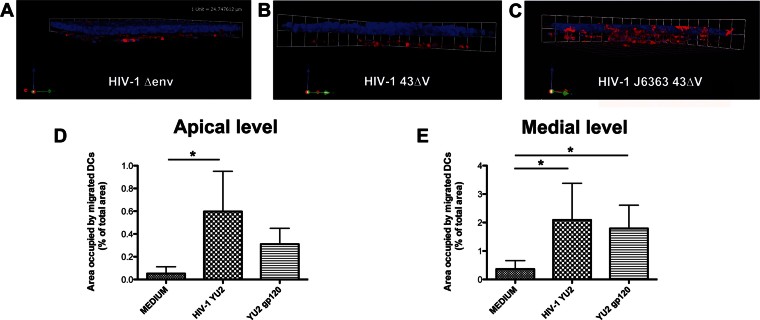Figure 7.
DCs migration is dependent from the viral envelope.
In the absence of the HIV-1 env as well as of the V1V3 env region, DCs did not migrate across the Caco-2 monolayer (A and B). The V1V3 env region of an R5 virus completely restored the migratory ability of DCs (C).
A–C. The Caco-2/DCs co-culture was incubated apically for 1.5 h with HIV-1 deleted of the env (HIV-1Δenv, 6 ng of p24 Ag) (A), the HIV-143ΔV deleted of the V1V3 region (40 ng of p24 Ag) as negative control (B) and a recombinant HIV-1 with the V1V3 env region of the R5 HIV-1J6363 primary virus recombined with the HIV-143ΔV backbone (HIV-1J6363-43ΔV, 20 ng of p24 Ag) (C). Three-dimensional reconstructions from CM z-series image stacks of the Caco-2/DCs culture stained for DAPI (epithelial cells and DCs; blue) and mouse anti-human DC-SIGN-PE (DCs; red) are shown.
D,E. The monolayer of the Caco-2/DCs system was incubated for 1.5 h with medium (negative control), HIV-1YU2 (positive control) or YU2 gp120 protein (100 ng/ml). Bar charts represent quantitative analysis of DCs migration across the Caco-2 cell at the apical (D) and medial (E) level of the cell monolayer (as in Fig 1). Results are expressed as percentage of area occupied by DCs compared to that of the whole field. Bars represent mean ± SD of three different fields of three different experiments. Statistic analysis was performed as described in Materials and Methods Section. *p < 0.05.

